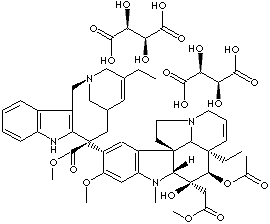PRODUCT IDENTIFICATION

H.S. CODE
TOXICITY
CLASSIFICATION
SMILES
PHYSICAL AND CHEMICAL PROPERTIES
REFRACTIVE INDEX
NFPA RATINGS
Health: 3, Flammability: 0, Reactivity: 0
AUTOIGNITION
FLASH POINT
GENERAL DESCRIPTION & APPLICATIONS
Vinorelbine ditartrate: The ditartrate salt of a semisynthetic vinca alkaloid derived from the leaves of the periwinkle plant (Vinca rosea) with antineoplastic properties. Vinorelbine binds to tubulin, thereby inhibiting tubulin polymerization into microtubules and spindle formation and resulting in apoptosis of susceptible cancer cells. Inhibition of mitotic microtubules correlates with antitumor activity, whereas inhibition of axonal microtubules seems to correlate with vinorelbine's neurotoxicity. Compared to related vinca alkaloids, vinorelbine is more selective against mitotic than axonal microtubules in vitro, which may account for its decreased neurotoxicity. This agent is also a radiation-sensitizing agent. (source: American Cancer Society)
Vinorelbine interferes with the cell's ability to reproduce. Vinorelbine is an intravenous (IV) medication. The type and extent of a cancer determines the exact dose and schedule of administering this medication. Vinorelbine slows or stops the growth and spread of cancer cells in the body. It is commonly used to treat non–small cell lung cancer, breast cancer, and bladder cancer. Vinorelbine is an effective antitumor medication. However, the type and extent of a cancer determines how effectively this medication slows or stops the growth of cancer cells in the body. (source: WebMD)
Mitotic inhibitors are often plant alkaloids and other compounds derived from natural products. They can stop mitosis or inhibit enzymes from making proteins needed for cell reproduction. These work during the M phase of the cell cycle but can damage cells in all phases. They are used to treat many different types of cancer including breast, lung, myelomas, lymphomas, and leukemias. These drugs are known for their potential to cause peripheral nerve damage, which can be a dose-limiting side effect. (source: American Cancer Society)
Mitotic Inhibitors
|
Product |
CAS RN. |
|
Vincristine |
57-22-7 |
| Colchicine | 64-86-8 |
| 2-Methoxyestradiol | 362-07-2 |
| Demecolcine | 477-30-5 |
| Podofilox | 518-28-5 |
| Vinblastine | 865-21-4 |
| Trifluralin | 1582-09-8 |
| Estramustine | 2998-57-4 |
| Benomyl | 17804-35-2 |
| Oryzalin | 19044-88-3 |
|
Teniposide |
29767-20-2 |
| Nocodazole | 31430-18-9 |
| Mebendazole | 31431-39-7 |
| Paclitaxel | 33069-62-4 |
| Etoposide | 33419-42-0 |
| Maytansine | 35846-53-8 |
| Vindesine | 53643-48-4 |
| Albendazole | 54965-21-8 |
| Phomopsin A | 64925-80-0 |
| Ansamitocins | 69279-90-9 |
| Vinorelbine | 71486-22-1 |
| Combretastatin | 82855-09-2 |
| Rhizoxin | 90996-54-6 |
| Dolastatin 10 | 110417-88-4 |
| Cryptophycin | 124689-65-2 |
| Disermolide | 127943-53-7 |
| Docetaxel | 148408-66-6 |
| Epothilone B | 152044-54-7 |
| Ixabepilone | 219989-84-1 |
APPEARANCE
ASSAY
99.0% min